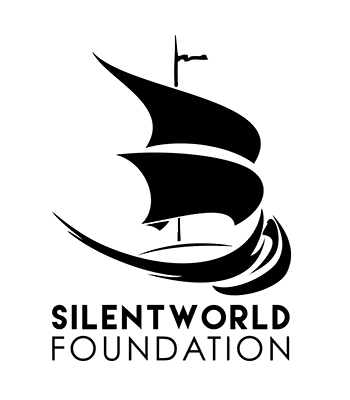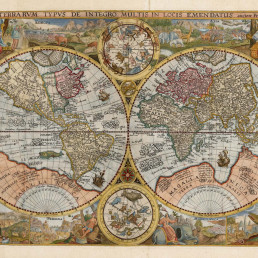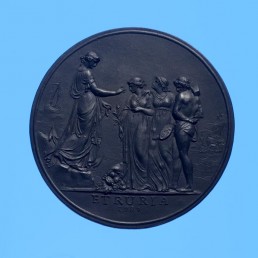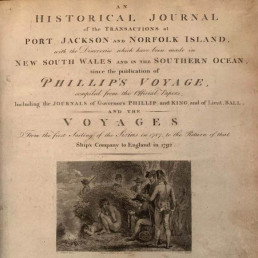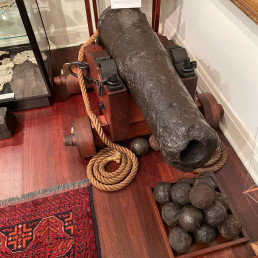
Name/TitleAboriginal king plate
About this objectKing plate. Aboriginal breastplate. “King Paddy of the Nyunga, Hall Outstation”.
In the early days of colonial Australia the governors and the land holders saw advantage in singling out certain Aboriginal people as leaders and distinguishing them in some way, so as to ensure their cooperation in the Europeans’ efforts to open up the land. A type of military gorget was chosen as a suitable badge of office: it had already been used in North America for the same purpose.
In Australia these became known as ‘king’, ‘brass’ or ‘breastplates’. They were presented not only to perceived ‘chiefs’ but to faithful servants and to the specially courageous – to many of the people, in fact, who helped in some way to ease the white people’s progress in the new land. They were presented from the earliest times through to the first decades of the twentieth century.
Jakelin Troy’s book titled King Plates: A History of Aboriginal Gorgets provides not only encouragement to scholars to engage in research in an area that has had little attention but to Aboriginal people seeking information about their forebears. In this book, they are called ‘gorgets’ because they were made not only for men and not only for people who were seen to be leaders. The name was also chosen because the plaques were modified copies of the gorgets worn as badges of office by infantry officers in Australia until 1832.
The gorgets are tangible physical links with Aboriginal people who were intimately involved in the colonial history of Australia. The names and affiliations inscribed on the gorgets are particularly important as documentary records of Aboriginal history. Ancestral connections with many contemporary Australians may be established through clues which the inscriptions provide.
(Source: National Museum of Australia)
MakerUnknown
Date Made19th century
Period19th century
Place MadeAustralia
Place NotesNoongar country, also known as the southwestern part of Western Australia.
Medium and MaterialsBronze
Inscription and Marks"King Paddy of the Nyunga, Hall Outstation"
Object TypeIndigenous History
Object numberSF001129
Copyright Licence![]() Attribution - Non-commercial - No Derivatives (cc)
Attribution - Non-commercial - No Derivatives (cc)
Explore by category
Maps and Charts
Date range: 1541-1836
Ship Models
Date range: 1629-1890
Maritime Paintings
Date range: 1793-1849
Manuscripts and Ephemera
Date range: 1768-c1850
Medallions & Convict Tokens
Date range: 1619-1880
Landscapes
Date range: 1768-c1850
Books
Date range: 1694-c1850
Currency and Shares
Date range: 1624-1823
Printed Material
Date range: 1541-1836
Maritime Archaeology
Date range: 1629-1854
Curator's corner
New acquisitions, staff favourites and curios
The mug is decorated with an underglaze and a blue transfer print. On the body, it is titled ‘Emigrants to Australia’. This type of body and glaze was discontinued by 1840. Comparison of the handle shape and the profile of the foot, point to the attribution of manufacture by the Davenport Factory.
Delta was a ship-rigged vessel with two decks and three masts. It was built in Dordrecht, Netherlands in 1839 at the shipyard of Jan Schouten and registered in the same port. Its hull was constructed of oak and sheathed in ‘yellow metal’. Delta was owned by H. van der Sande at the time of its loss and was engaged as a cargo trader.
The Delta carried 29 crew and passengers, while sailing from Melbourne to Batavia in ballast when wrecked at Kenn Reefs on 30 May 1854 whilst under the command of Captain J.G. Kunst. This vessel loss supports the pattern of shipwrecks located on a well-travelled shipping route that was poorly charted until the mid-nineteenth century. The crew of the Delta could see four other shipwrecks at Kenn Reefs at the time of their vessel’s loss.
Important image of a ship associated with Matthew Flinders, that would shortly become one of the most famous early shipwrecks in eastern Australian waters. This is a fine ship’s portrait, by one of the great exponents of the art
